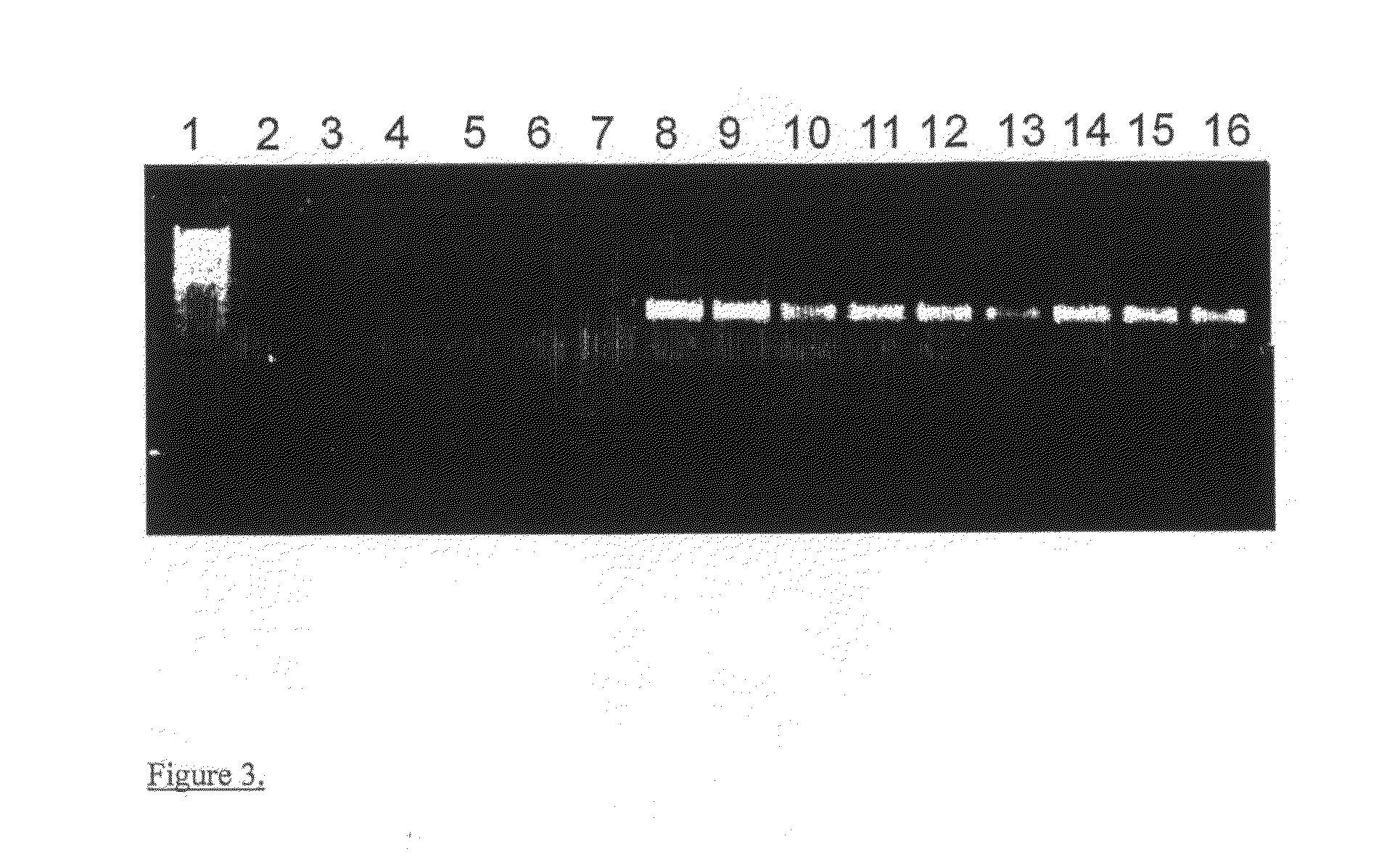PCR diagnostics of dermatophytes and other pathogenic fungi
a technology of dermatophytes and pathogenic fungi, applied in the field of pcr diagnostics of dermatophytes and other pathogenic fungi, can solve the problems of low sensitivity of techniques, false negatives, and long-term systemic treatment, and achieve the effects of reducing the number of cases, and improving the diagnostic accuracy
- Summary
- Abstract
- Description
- Claims
- Application Information
AI Technical Summary
Benefits of technology
Problems solved by technology
Method used
Image
Examples
example 1
Primer Designing
[0107]The dermatophyte, Trichophyton rubrum, Microsporum canis, Trichophyton mentagrophytes-Trichophyton tonsurans complex or Epidermophyton floccosum specific primers were selected from available DNA sequences listed in Table 1. The alignment of respective sequences allowed the design of primer-pairs detecting all of the dermatophyte species (in case of panDerm1 and panDerm2 oligonucleotides), species belonging to Microsporum genus (in case of Micr773-for and Micr885-rev oligonucleotides), species belonging to Trichophyton genus (in case of Trichopyros-for and Trichopyros-rev oligonucleotides) and for specific detection of Trichophyton rubrum, Microsporum canis, Trichophyton mentagrophytes-Trichophyton tonsurans complex or Epidermophyton floccosum.
TABLE 1The sequenced used in primers designing.Gene Bank ™ accession number(www.ncbi.nih.gov)Arthoderma benhamiaeAB044155Arthoderma benhamiaeAB003558Arthoderma gypseumAB003568Arthoderma simiiAB003564Arthoderma vanbreuseghe...
example 2
[0108]Evaluation of the specificity of dermatophyte, genus Trichophyton, genus Microsporum, Trichophyton rubrum, Epidermophyton floccosum, Microsporum canis and Trichophyton mentagrophytes-Trichophyton tonsurans complex specific primers.
Materials and Methods
[0109]Strains. A list of the type, references and clinical fungal strains used in the study is presented in Table 2 Twelve strains were obtained from the National Collection of Pathogenic Fungi (United Kingdom). Clinical strains were obtained from Mycology Laboratory of Statens Serum Institute (SSI, Denmark). All clinical isolates were identified by colony characteristics and micro-morphology.
TABLE 2Microorganism used in the study.Number ofMicroorganismNCPF numberclinical isolatesMicrosporum gypseumNCPF-402Microsporum canisNCPF-17710Microsporum nanum—1Microsporum audouiniiNCPF-4365Trichophyton mentagrophytesNCPF-22410var. mentagrophytesTrichophyton mentagrophytesNCPF-780var. interdigitaleTrichophyton schoenleniniiNCPF-124—Trichop...
example 3
DNA Extraction Method—the Protocol for Invented DNA Extraction Method from Dermatophyte Infected Nails
[0125]Sixty-four nail samples were randomly chosen from samples received at the Laboratory of Mycology at SSI for microscopy and culture of dermatophytes and Candida (Table 3). Fourteen were diagnosed as T. rubrum, two as T. mentagrophytes, one as a T. tonsurans, two as Aspergillus sp., two as Candida sp., one as Alternaria sp., three as Acremonium sp. and 39 were found negative.
TABLE 3Microorganisms used in the studySpecimen diagnosed byroutine Mycology Lab asNumber of clinical isolatesTrichophyton rubrum14Trichophyton mentagrophytes2Aspergillus sp.2Candida sp.2Acremonium sp.3Alternaria1Trichophyton tonsurans1Negatives (no growth of any fungi)39
[0126]DNA from 64 clinical specimens listed in table 3 were extracted according to the following protocol:[0127]1. The nails were placed in 2 ml Eppendorf tubes[0128]2. 100 μl (can be increased up to 500) lysis buffer L1 (250 mM KCl, 60 mM N...
PUM
| Property | Measurement | Unit |
|---|---|---|
| Temperature | aaaaa | aaaaa |
| Temperature | aaaaa | aaaaa |
| Temperature | aaaaa | aaaaa |
Abstract
Description
Claims
Application Information
 Login to View More
Login to View More - R&D
- Intellectual Property
- Life Sciences
- Materials
- Tech Scout
- Unparalleled Data Quality
- Higher Quality Content
- 60% Fewer Hallucinations
Browse by: Latest US Patents, China's latest patents, Technical Efficacy Thesaurus, Application Domain, Technology Topic, Popular Technical Reports.
© 2025 PatSnap. All rights reserved.Legal|Privacy policy|Modern Slavery Act Transparency Statement|Sitemap|About US| Contact US: help@patsnap.com



